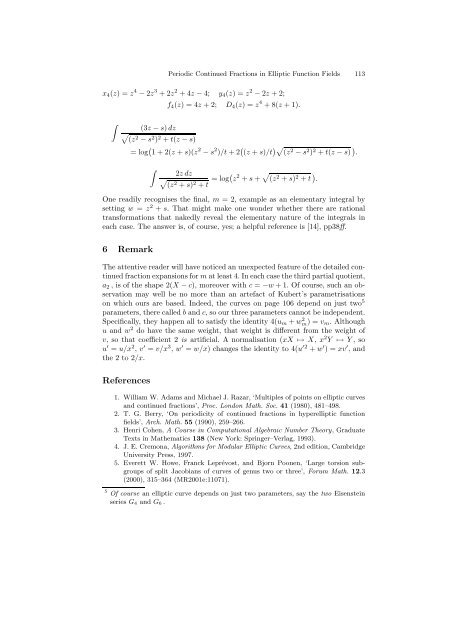Periodic Continued Fractions in Elliptic Function Fields - Macquarie ...
Periodic Continued Fractions in Elliptic Function Fields - Macquarie ...
Periodic Continued Fractions in Elliptic Function Fields - Macquarie ...
You also want an ePaper? Increase the reach of your titles
YUMPU automatically turns print PDFs into web optimized ePapers that Google loves.
<strong>Periodic</strong> <strong>Cont<strong>in</strong>ued</strong> <strong>Fractions</strong> <strong>in</strong> <strong>Elliptic</strong> <strong>Function</strong> <strong>Fields</strong> 113<br />
x4(z) =z 4 − 2z 3 +2z 2 +4z − 4; y4(z) =z 2 − 2z +2;<br />
<br />
f4(z) =4z +2; D4(z) =z 4 +8(z +1).<br />
(3z − s) dz<br />
<br />
(z2 − s2 ) 2 + t(z − s)<br />
= log 1+2(z + s)(z 2 − s 2 )/t +2 (z + s)/t (z2 − s2 ) 2 + t(z − s) .<br />
<br />
2zdz<br />
(z 2 + s) 2 + t = log z 2 + s + (z 2 + s) 2 + t .<br />
One readily recognises the f<strong>in</strong>al, m =2,example as an elementary <strong>in</strong>tegral by<br />
sett<strong>in</strong>g w = z 2 + s. That might make one wonder whether there are rational<br />
transformations that nakedly reveal the elementary nature of the <strong>in</strong>tegrals <strong>in</strong><br />
each case. The answer is, of course, yes; a helpful reference is [14], pp38ff.<br />
6 Remark<br />
The attentive reader will have noticed an unexpected feature of the detailed cont<strong>in</strong>ued<br />
fraction expansions for m at least 4. In each case the third partial quotient,<br />
a2 ,isofthe shape 2(X − c), moreover with c = −w +1.Ofcourse, such an observation<br />
may well be no more than an artefact of Kubert’s parametrisations<br />
on which ours are based. Indeed, the curves on page 106 depend on just two 5<br />
parameters, there called b and c, soour three parameters cannot be <strong>in</strong>dependent.<br />
Specifically, they happen all to satisfy the identity 4(um + w 2 m)=vm. Although<br />
u and w 2 do have the same weight, that weight is different from the weight of<br />
v, sothat coefficient 2 is artificial. A normalisation (xX ↦→ X, x 2 Y ↦→ Y ,so<br />
u ′ = u/x 2 , v ′ = v/x 3 , w ′ = w/x) changes the identity to 4(u ′2 + w ′ )=xv ′ , and<br />
the 2 to 2/x.<br />
References<br />
1. William W. Adams and Michael J. Razar, ‘Multiples of po<strong>in</strong>ts on elliptic curves<br />
and cont<strong>in</strong>ued fractions’, Proc. London Math. Soc. 41 (1980), 481–498.<br />
2. T. G. Berry, ‘On periodicity of cont<strong>in</strong>ued fractions <strong>in</strong> hyperelliptic function<br />
fields’, Arch. Math. 55 (1990), 259–266.<br />
3. Henri Cohen, A Course <strong>in</strong> Computational Algebraic Number Theory, Graduate<br />
Texts <strong>in</strong> Mathematics 138 (New York: Spr<strong>in</strong>ger–Verlag, 1993).<br />
4. J. E. Cremona, Algorithms for Modular <strong>Elliptic</strong> Curves, 2nd edition, Cambridge<br />
University Press, 1997.<br />
5. Everett W. Howe, Franck Leprévost, and Bjorn Poonen, ‘Large torsion subgroups<br />
of split Jacobians of curves of genus two or three’, Forum Math. 12.3<br />
(2000), 315–364 (MR2001e:11071).<br />
5 Of course an elliptic curve depends on just two parameters, say the two Eisenste<strong>in</strong><br />
series G4 and G6 .

















